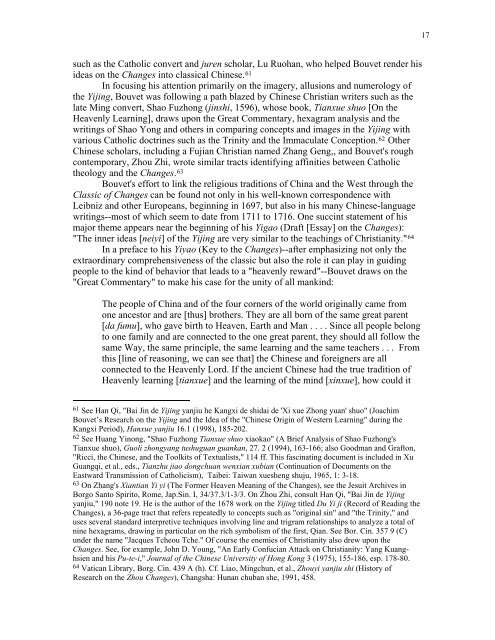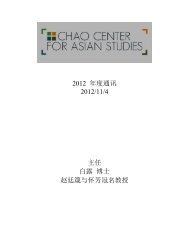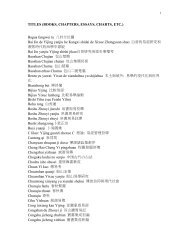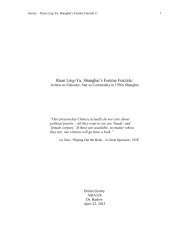Jesuit Interpretations of the Yijing - Chao Center for Asian Studies ...
Jesuit Interpretations of the Yijing - Chao Center for Asian Studies ...
Jesuit Interpretations of the Yijing - Chao Center for Asian Studies ...
Create successful ePaper yourself
Turn your PDF publications into a flip-book with our unique Google optimized e-Paper software.
17<br />
such as <strong>the</strong> Catholic convert and juren scholar, Lu Ruohan, who helped Bouvet render his<br />
ideas on <strong>the</strong> Changes into classical Chinese. 61<br />
In focusing his attention primarily on <strong>the</strong> imagery, allusions and numerology <strong>of</strong><br />
<strong>the</strong> <strong>Yijing</strong>, Bouvet was following a path blazed by Chinese Christian writers such as <strong>the</strong><br />
late Ming convert, Shao Fuzhong (jinshi, 1596), whose book, Tianxue shuo [On <strong>the</strong><br />
Heavenly Learning], draws upon <strong>the</strong> Great Commentary, hexagram analysis and <strong>the</strong><br />
writings <strong>of</strong> Shao Yong and o<strong>the</strong>rs in comparing concepts and images in <strong>the</strong> <strong>Yijing</strong> with<br />
various Catholic doctrines such as <strong>the</strong> Trinity and <strong>the</strong> Immaculate Conception. 62 O<strong>the</strong>r<br />
Chinese scholars, including a Fujian Christian named Zhang Geng,, and Bouvet's rough<br />
contemporary, Zhou Zhi, wrote similar tracts identifying affinities between Catholic<br />
<strong>the</strong>ology and <strong>the</strong> Changes. 63<br />
Bouvet's ef<strong>for</strong>t to link <strong>the</strong> religious traditions <strong>of</strong> China and <strong>the</strong> West through <strong>the</strong><br />
Classic <strong>of</strong> Changes can be found not only in his well-known correspondence with<br />
Leibniz and o<strong>the</strong>r Europeans, beginning in 1697, but also in his many Chinese-language<br />
writings--most <strong>of</strong> which seem to date from 1711 to 1716. One succint statement <strong>of</strong> his<br />
major <strong>the</strong>me appears near <strong>the</strong> beginning <strong>of</strong> his Yigao (Draft [Essay] on <strong>the</strong> Changes):<br />
"The inner ideas [neiyi] <strong>of</strong> <strong>the</strong> <strong>Yijing</strong> are very similar to <strong>the</strong> teachings <strong>of</strong> Christianity." 64<br />
In a preface to his Yiyao (Key to <strong>the</strong> Changes)--after emphasizing not only <strong>the</strong><br />
extraordinary comprehensiveness <strong>of</strong> <strong>the</strong> classic but also <strong>the</strong> role it can play in guiding<br />
people to <strong>the</strong> kind <strong>of</strong> behavior that leads to a "heavenly reward"--Bouvet draws on <strong>the</strong><br />
"Great Commentary" to make his case <strong>for</strong> <strong>the</strong> unity <strong>of</strong> all mankind:<br />
The people <strong>of</strong> China and <strong>of</strong> <strong>the</strong> four corners <strong>of</strong> <strong>the</strong> world originally came from<br />
one ancestor and are [thus] bro<strong>the</strong>rs. They are all born <strong>of</strong> <strong>the</strong> same great parent<br />
[da fumu], who gave birth to Heaven, Earth and Man . . . . Since all people belong<br />
to one family and are connected to <strong>the</strong> one great parent, <strong>the</strong>y should all follow <strong>the</strong><br />
same Way, <strong>the</strong> same principle, <strong>the</strong> same learning and <strong>the</strong> same teachers . . . From<br />
this [line <strong>of</strong> reasoning, we can see that] <strong>the</strong> Chinese and <strong>for</strong>eigners are all<br />
connected to <strong>the</strong> Heavenly Lord. If <strong>the</strong> ancient Chinese had <strong>the</strong> true tradition <strong>of</strong><br />
Heavenly learning [tianxue] and <strong>the</strong> learning <strong>of</strong> <strong>the</strong> mind [xinxue], how could it<br />
61 See Han Qi, "Bai Jin de <strong>Yijing</strong> yanjiu he Kangxi de shidai de 'Xi xue Zhong yuan' shuo" (Joachim<br />
Bouvet’s Research on <strong>the</strong> <strong>Yijing</strong> and <strong>the</strong> Idea <strong>of</strong> <strong>the</strong> "Chinese Origin <strong>of</strong> Western Learning" during <strong>the</strong><br />
Kangxi Period), Hanxue yanjiu 16.1 (1998), 185-202.<br />
62 See Huang Yinong, "Shao Fuzhong Tianxue shuo xiaokao" (A Brief Analysis <strong>of</strong> Shao Fuzhong's<br />
Tianxue shuo), Guoli zhongyang tushuguan guankan, 27. 2 (1994), 163-166; also Goodman and Grafton,<br />
"Ricci, <strong>the</strong> Chinese, and <strong>the</strong> Toolkits <strong>of</strong> Textualists," 114 ff. This fascinating document is included in Xu<br />
Guangqi, et al., eds., Tianzhu jiao dongchuan wenxian xubian (Continuation <strong>of</strong> Documents on <strong>the</strong><br />
Eastward Transmission <strong>of</strong> Catholicism), Taibei: Taiwan xuesheng shuju, 1965, 1: 3-18.<br />
63 On Zhang's Xiantian Yi yi (The Former Heaven Meaning <strong>of</strong> <strong>the</strong> Changes), see <strong>the</strong> <strong>Jesuit</strong> Archives in<br />
Borgo Santo Spirito, Rome, Jap.Sin. I, 34/37.3/1-3/3. On Zhou Zhi, consult Han Qi, "Bai Jin de <strong>Yijing</strong><br />
yanjiu," 190 note 19. He is <strong>the</strong> author <strong>of</strong> <strong>the</strong> 1678 work on <strong>the</strong> <strong>Yijing</strong> titled Du Yi ji (Record <strong>of</strong> Reading <strong>the</strong><br />
Changes), a 36-page tract that refers repeatedly to concepts such as "original sin" and "<strong>the</strong> Trinity," and<br />
uses several standard interpretive techniques involving line and trigram relationships to analyze a total <strong>of</strong><br />
nine hexagrams, drawing in particular on <strong>the</strong> rich symbolism <strong>of</strong> <strong>the</strong> first, Qian. See Bor. Cin. 357 9 (C)<br />
under <strong>the</strong> name "Jacques Tcheou Tche." Of course <strong>the</strong> enemies <strong>of</strong> Christianity also drew upon <strong>the</strong><br />
Changes. See, <strong>for</strong> example, John D. Young, "An Early Confucian Attack on Christianity: Yang Kuanghsien<br />
and his Pu-te-i," Journal <strong>of</strong> <strong>the</strong> Chinese University <strong>of</strong> Hong Kong 3 (1975), 155-186, esp. 178-80.<br />
64 Vatican Library, Borg. Cin. 439 A (h). Cf. Liao, Mingchun, et al., Zhouyi yanjiu shi (History <strong>of</strong><br />
Research on <strong>the</strong> Zhou Changes), Changsha: Hunan chuban she, 1991, 458.








